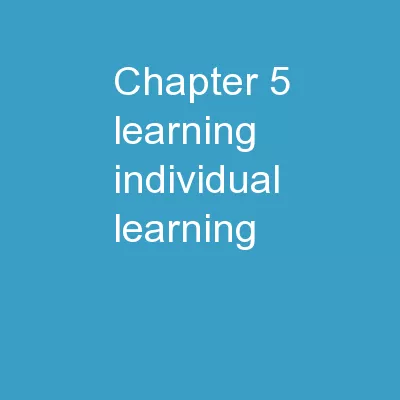

How do animals learn Why What Sheehan and Tibbetts 2011 Individual Learning Shettleworth 1998 Learning is a relatively permanent change in behavior as a result from experience Phenotypic Plasticity production of different phenotypes as a result of different environmental condi ID: 752657
Download Presentation The PPT/PDF document "Chapter 5: Learning Individual learning" is the property of its rightful owner. Permission is granted to download and print the materials on this web site for personal, non-commercial use only, and to display it on your personal computer provided you do not modify the materials and that you retain all copyright notices contained in the materials. By downloading content from our website, you accept the terms of this agreement.
Slide1
Chapter 5: LearningIndividual learningHow do animals learnWhy?What?Slide2
Sheehan and Tibbetts, 2011Slide3
Individual LearningShettleworth (1998): Learning is a “relatively permanent change in behavior as a result from experience.”Phenotypic Plasticity: production of different phenotypes as a result of different environmental conditions(phenotype: the set of observable characteristics of an organism)Slide4
Changes in colonial bryozoans as a result of predation: spine production in response to predators in Membranipora
membranacea
Dugatkin
suggests: Learning is a subset of phenotypic plasticitySlide5
Membranipora
membranacea
colonies exposed to predator tainted water.
(
Harvell
, 1991)Slide6
Learning is a subset of phenotypic plasticity; but all phenotypic plasticity is not necessarily learning.Jablonski, et al, 2006, looked at wing flapping and tail flipping in birds as a learned response. Birds may do this to “flush” insects from trees and the eat them.This may be learned, or it may be fixed (see Lorenz , “fixed action pattern) or perhaps both.Slide7
Jablonski found that Painted Redstarts birds increase flapping when under branches in the field; but they also do this in the lab; even when they are not rewarded for the behavior. “Naïve” birds have the same response as experienced birds.Thus, increased flapping under branches is an example of phenotypic plasticity (producing different phenotypes under different environmental conditions), but it not learning. Slide8
Single stimulus learning: the blue stick experimentHabituation versus SensitizationSlide9Slide10
Pavlov’s work 1898 through 1930Pavlovian ConditioningConditioned Stimulus: the blue stick, the bell, the stimulus that initially fails to produce a responseUnconditioned Stimulus: the cat odor, the meat powder, the stimulus that elicits a strong response Slide11Slide12
The Conditioned Response Slide13Slide14Slide15Slide16
Operant ConditioningOperant (goal-directed) Response
Instrumental Learning
Slide17
Why do animal’s learn?
Adaptation
Natural Selection
Do animals forget?
Slide18
Extinction is the weakening and ultimately the ending of the paired association of stimuli and response in learning experiments… forgetting Slide19
Learning in populations Slide20Slide21
Group learning and antipredator response in three-spines sticklebacks Slide22
Evolution of Learning
Does Natural Selection favor the
ability
to learn?
Is there accost to learning and can we select for the ability (genetic basis)?
Slide23
Evolutionary tradeoffsand Environmental Stability
Slide24
What can animal’s learn?About predators
About mates
About animal relationships
About aggression
Slide25Slide26Slide27Slide28
Learning about mates
Mating systems, parental investment and selection for learning
Slide29
Learning about kin:Helpers at the nest and indirect fitness
Slide30
Learning may shape aggressive behavior
Slide31